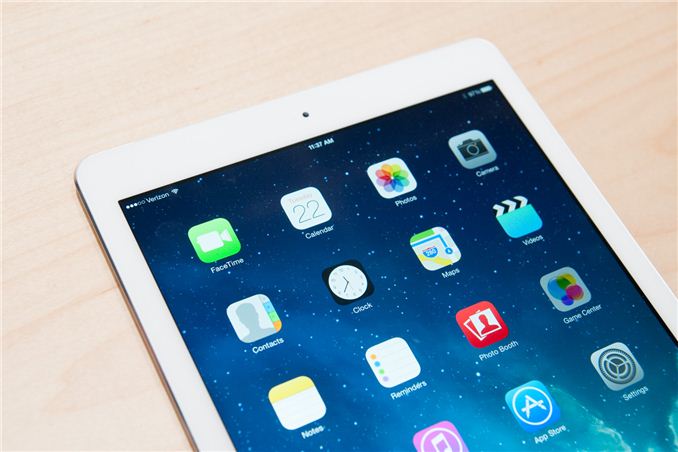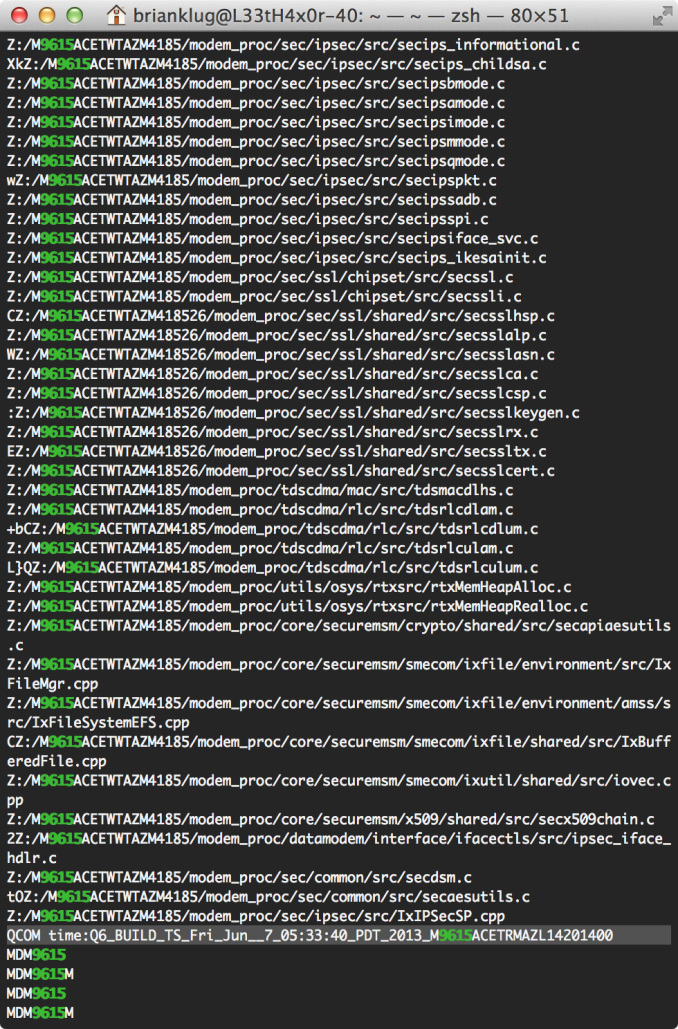iPad Air and iPad Mini with Retina Display include Qualcomm's MDM9615 baseband
by Brian Klug on October 24, 2013 9:24 PM EST
We've had a few days to digest everything announced at Apple's recent event, and one of the remaining questions was whether the iPad Air and iPad Mini with Retina Display have faster cellular connectivity. Apple dramatically increased the number of LTE bands supported on the new iPads, and this time has a single FDD-LTE SKU for the Americas, EMEA, and a few other markets, with bands 1, 2, 3, 4, 5, 7, 8, 13, 17, 18, 19, 20, 25, and 26 supported on the cellular-enabled models that have been announced so far.
Of course the immediate question was what cellular stack is inside, and thankfully we can easily get this without a teardown by looking at the software already made available by Apple for restoring the new iPads. I strongly suspected shared platform between 5s/5c and the new iPads given the 1.02.02 baseband version I saw on the iPads in the demo room and subsequent update to baseband version 1.02.02 on the 5s and 5c with iOS 7.0.3, but dug a bit deeper.
I went ahead and looked around inside, and can confirm that the new iPads have the strings and certificates I'd expect to indicate MDM9615. I can confirm the new iPads use Qualcomm's 2nd Generation MDM9615 multimode LTE baseband which we've covered extensively before.
| iPad Cellular Speeds | ||||||
| Property | iPhone 3G/3GS/iPad 1 3G | iPhone 4 / iPad 2 (GSM/UMTS) | iPhone 4 / iPad 2 (CDMA) | iPad 3 | iPad 4/iPad Mini | iPad Air/iPad Mini w/Retina |
| Baseband | Infineon X-Gold 608 | Infineon X-Gold 618 | Qualcomm MDM6600 | Qualcomm MDM9600 | Qualcomm MDM9615 w/RTR8600 |
Qualcomm MDM9615 w/WTR1605L |
| Max 3GPP Release Feature | Release 5 | Release 6 | Release 7 | Release 9 | Release 9 | Release 9 |
| HSDPA Category | Cat.8 - 7.2 Mbps | Cat.8 - 7.2 Mbps | N/A | Cat. 24 - 42 Mbps | Cat. 24 - 42 Mbps | Cat. 24 - 42 Mbps |
| HSUPA Category | None - 384 Kbps WCDMA only | Cat.6 - 5.76 Mbps | N/A | Cat.6 - 5.76 Mbps | Cat.6 - 5.76 Mbps | Cat.6 - 5.76 Mbps |
| EVDO | N/A | N/A | 1x/EVDO Rev.A | 1x/EVDO Rev.A | 1x/EVDO Rev.A | 1x/EVDO Rev.A |
| LTE | N/A | N/A | N/A | 100/50 UE Cat. 3 | 100/50 UE Cat. 3 | 100/50 UE Cat. 3 |
That means LTE Category 3 speeds of up to 100 Mbps on the downlink if you're in a 20 MHz market. It looks like it will still be a while before we see Apple move to MDM9x25 and be able to enjoy Category 4 speeds of 150 Mbps on a 20 MHz LTE channel. I'm also confident that the increased band set also is partially thanks to transceiver moving up to WTR1605L.
It isn't news, but I've also confirmed that there are the appropriate references to Apple's S5L8960X SoC (otherwise known as Apple's A7) in the iPad Air and iPad mini with Retina Display software bundles, same as the iPhone 5s. There's no funny buisness from what I can tell, at least as far as we can get superficially without a teardown it appears it's indeed the same A7 silicon in there.












10 Comments
View All Comments
iwod - Friday, October 25, 2013 - link
But would the old iPad Mini be using the Qualcomm MDM9615 w/WTR1605L as well. As with the iPhone 5C changed to those as well. ( So Straightly speaking 5C isn't really an iPhone 5 with different shell )evonitzer - Friday, October 25, 2013 - link
They discussed this either on the podcast on in the 5C review. You are right that the 5C is not exactly a 5 in plastic clothes. Where it makes sense, Apple sourced the same part for the 5S and 5C, resulting in a few little improvements.ssiu - Friday, October 25, 2013 - link
Dos the S5L8960X also imply 1GB RAM for both iPad Air and iPad mini retina? (Or are the memory separate from the A7 so S5L8960X doesn't give any clue one way or another.)Shadowmaster625 - Friday, October 25, 2013 - link
What the heck are you going to do with that kind of bandwidth on a stupid dumbed down tablet that wont even fully buffer a youtube video incase you want to watch it in airplane mode? I think youtube has added such a feature but still that is beside the point. By defualt these things buffer next to nothing.evonitzer - Friday, October 25, 2013 - link
I'm probably feeding a troll right now, but Brian discusses the reason for greater bandwidth all the time. Rush to sleep. Better battery life can be achieved by downloading everything super quick and then putting the radio to sleep.Wolfpup - Friday, October 25, 2013 - link
I don't see how he's trolling. I'm not sure how any of that applies except for background tasks like syncing mail/calendars? Maybe that matters for that though.Belegost - Friday, October 25, 2013 - link
Two reasons:1 - That bandwidth is not dedicated to your phone. The cell has a certain amount of time/frequency resources that it has to multiplex with all users demanding simultaneous access. The peak throughput is a (rough) measure of a device's efficiency at receiving data. So imagine a case where two users are trying to download from the same cell at the same time - the cell gives user A 1 second of data, then user B 1 second of data, back to A, then B...
So if user A can receive a peak of 150Mbps and user B only 100Mbps, then the best each could do would be 75Mbps for A, and 50Mbps for B averaged over time. So A will receive the same data 50% sooner than B, and when A is done, then B gets his data faster since all the resources can be devoted to B. So because A has a faster handset, BOTH A and B get better service when they are trying to use the same cell.
Now extend that to 100 users, if user A has 150Mbps handset, but everyone else has 100Mbps, then user A gets an average of 1.5Mbps, and the others only 1Mbps. That is a very noticeable difference in any data activity. So in the long run, having more efficient phones will enable better performance even when the network is increasingly loaded.
2 - It was mentioned by another commenter, but awake time for the modem is controlled by how quickly data can be moved, the faster data is finished the sooner the modem can return to a low power mode. This may not seem like much comparing 150Mbps to 100Mbps as most data transmissions at those rates would be really fast. But when the network is not empty those rates fall, and awake times for all users increase.
Also to answer the comment made that it would only help background tasks. Not at all true. Even when a user is actively browsing a website, the majority of data traffic is in a burst when something new is done, while the user is reading text, or scrolling the page, the modem can go to sleep. It's important to remember that things that seem really fast on human time scales are actually really slow in silicon timescale, so sleep gating can be done on sub-millisecond time scales, and in the two seconds you take to find the link you want on a page and click to start a new page, the modem has probably gone to sleep and woken up hundreds of times.
Wolfpup - Friday, October 25, 2013 - link
It feels kind of weird for Apple to switch back to just a single chip for both iPhone and iPad. iPad mini I can see (I guess), but I was hoping for something beefier for the iPad 5.Oh well, I guess this chip's GPU beats the 4's regardless, so...
Was hoping for some kind of interesting new hybrid device too...
solipsism - Saturday, October 26, 2013 - link
That's one way to look at it but another would be that this is the beefier chip but it's also being used in the iPhone 5S. Perhaps clocked a little lower and/or there are some aspects of the chip that isn't enabled on the iPhone but is on the iPads. Check out the memory bus in the 5S review.At some point this was likely to merge. I didn't think it would be this soon but it was bound to happen. Have you considered how the Retina iPad Mini can get 10 hours of battery life but the same chip with a beefier battery still only gets 10 hours of battery life? They are now pushing the same number of pixels so the only real difference in power would be MIMO and the ≈50% larger backlight, right? Is that enough to account for everything or is it possible the A7 in the iPad Mini is clocked lower?
Nawy - Monday, September 22, 2014 - link
Hello my friends, I don't know to much on this but tell me something, if the ipad mini retina and the ipad air have the same database and the same processor what they need to be a phone, that, is it possible?, thank you